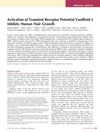TLDR A specific gene mutation causes Olmsted syndrome.
Olmsted syndrome (OS) is a rare congenital skin disorder caused by gain-of-function mutations in the TRPV3 gene, characterized by severe keratoderma, alopecia, onychodystrophy, and pruritus. This report described the first Korean case of OS in a 3-year-old girl with a heterozygous p.Gly568Val missense mutation in TRPV3, presenting with severe palmoplantar keratoderma, pruritic eczematous lesions, and thin, sparse hair. Genetic analysis confirmed the mutation was de novo. Treatment with systemic acitretin and topical therapies provided moderate improvement. The study highlighted the phenotypic diversity of TRPV3-related OS and suggested potential future treatments targeting TRPV3.
27 citations
,
June 2015 in “Journal of Investigative Dermatology” TRPV3 gene mutations cause Olmsted syndrome symptoms, but severity varies.
56 citations
,
January 2014 in “Journal of Investigative Dermatology” Olmsted syndrome can be inherited as an autosomal recessive trait due to a rare TRPV3 gene mutation.
 105 citations
,
May 2011 in “The journal of investigative dermatology/Journal of investigative dermatology”
105 citations
,
May 2011 in “The journal of investigative dermatology/Journal of investigative dermatology” Activating TRPV3 stops human hair growth.
 November 2019 in “Harper's Textbook of Pediatric Dermatology”
November 2019 in “Harper's Textbook of Pediatric Dermatology” The document is a detailed medical reference on skin and genetic disorders.
56 citations
,
January 2014 in “Journal of Investigative Dermatology” Olmsted syndrome can be inherited as an autosomal recessive trait due to a rare TRPV3 gene mutation.
 November 2019 in “Harper's Textbook of Pediatric Dermatology”
November 2019 in “Harper's Textbook of Pediatric Dermatology” Understanding normal hair growth and loss in children is key to diagnosing and treating hair disorders.
9 citations
,
August 2021 in “Journal of clinical medicine” Pili torti is a rare condition where hair is twisted and breaks easily, often linked to genetic disorders or other health issues.
2 citations
,
June 2013 in “Journal of Dermatological Case Reports” Olmsted syndrome is a rare skin disorder causing thickened skin and other symptoms.


